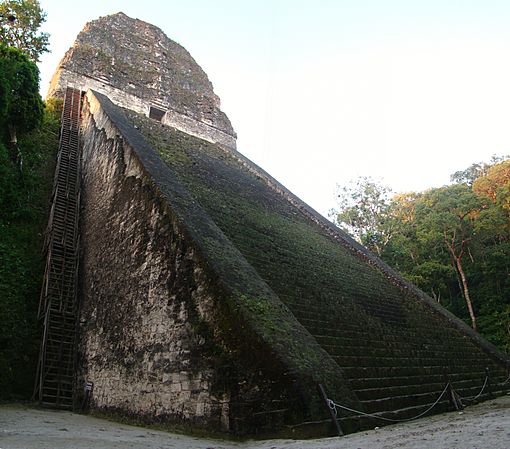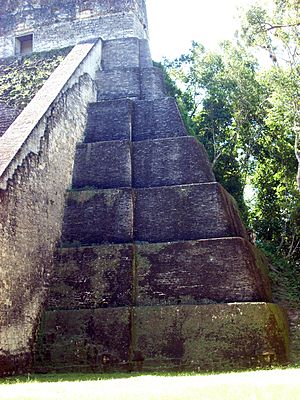Tikal Temple V facts for kids
Tikal Temple V is a very tall pyramid at Tikal, an ancient city built by the Maya people. Tikal is one of the most important old Maya sites. You can find it in northern Guatemala.
Temple V stands south of the city's main area, called the Central Acropolis. It was built as a special burial place for a Maya ruler whose name we don't know yet. This temple is about 57 meters (187 feet) tall! That makes it the second tallest building in Tikal. Only Temple IV is taller. Experts believe Temple V was built around the year 700 AD. This was during the Late Classic period of Maya history. Scientists used special tests like radiocarbon dating to figure out its age.
The way Temple V was built shows some older Maya styles. For example, it has wide railings next to the main stairs. Its corners are also rounded. These features were popular in earlier times, showing that old traditions were still important.
Contents
Where is Tikal Temple V Located?
Temple V is in the southern part of Tikal's main area. It sits on a high ridge that also holds other important structures. These include the Lost World complex and the Plaza of the Seven Temples.
During the Late Classic period, it was hard to get to Temple V. A large water reservoir was to its north. Other buildings blocked access from the west and east. Unlike other big temples in Tikal, Temple V was not connected to the city's special stone roads, called sacbeob. This might mean that people stopped using it or taking care of it a long time ago. This could also explain why it's not as well-preserved as other main temples.
What Does Tikal Temple V Look Like?
The pyramid sits on a platform that is 5 meters (16 feet) higher than the main plaza. This platform was built very strongly. Workers used large stone walls and filled them with layers of earth and stone. This made the ground flat and strong enough to hold the huge temple.
The base of the pyramid covers a large area, about 2050 square meters (22,066 square feet). The pyramid itself is 36 meters (118 feet) wide from north to south and 51 meters (167 feet) long from east to west. It has seven stepped levels, each about 4 meters (13 feet) high. A unique feature of Temple V is its rounded corners. No other major temple at Tikal has these.
The main stairway is 20 meters (66 feet) wide. It faces north, which is unusual for Tikal's big temples. Most others face east or west. This stairway has about 90 steps. Its side railings are 2.6 meters (8.5 feet) wide and go all the way up the stairs. This type of railing was common in earlier Maya buildings.
The Shrine at the Top
The small building at the very top of the pyramid is called a shrine. It has only one tiny room, which is just 90 centimeters (35 inches) deep. The wall behind this room is very thick, about 4.57 meters (15 feet). This room is the smallest of any shrine in Tikal's big temples.
Above the room are three hidden, arched spaces. These spaces were built to make the whole structure lighter. The shrine still has its original wooden beams above the doorways. The front of the shrine, on the north side, is decorated. It has three masks of the Maya rain god Chaac. There are also frames with human figures on the sides.
The Roof Comb
On top of the shrine is a very large decoration called a roof comb. It's about 12.5 meters (41 feet) tall! To make it lighter, it has 11 or 12 empty, arched spaces inside. The roof comb has four stepped sections. The lowest section on the north side has a very big mask of the god Chaac. On either side of this mask are two more masks that look like the Maya sun god.
Cool Finds Inside and Around Temple V
Archaeologists found several interesting things near and under Temple V. These finds tell us more about the people who built and used this amazing pyramid.
Offering 1
This offering was found in the platform just north of the main stairs. It was made of two ceramic bowls placed rim-to-rim. Inside, there was another small bowl, a tiny ceramic pot, and three shells. The shells had holes, suggesting they were used as jewelry. These items were from an earlier time, but they were found in a later context.
Offering 2
This offering was buried right under the pyramid itself. It seems to have been a special gift placed before construction began. It included five used incense burners. There was also evidence that wood and incense had been burned. Two of the burners were shaped like cylinders with masks of the sun god. They even had traces of red and blue paint! The other three burners were shaped like human figures. All these items are from the Late Classic period.
Burial 1
This burial was found near Offering 1. It was the skeleton of a teenage girl, about 15 years old. She was placed in a curled-up position, facing west. Her teeth had small holes, likely for decoration. It looked like she died from a serious infection, possibly from a tooth problem. An earthenware bowl was placed near her right knee. This burial is also from the Late Classic period.
Burial 2
Archaeologists found this burial by digging tunnels under the pyramid. The body was placed in a small stone box, called a cist. Two ceramic pots covered the top of the cist. What's unusual is that the cist was covered with wooden planks instead of stone slabs. These planks fit into special slots.
The remains belonged to a young adult male, aged 18 to 22. He was about 1.62 meters (5 feet 4 inches) tall, which was a bit taller than average for Maya men at that time. His skull was long and flat, which means his head was shaped on purpose when he was a baby. His teeth were also filed and had holes. Some of the holes in his lower teeth still had shiny pyrite (fool's gold) decorations. He seemed healthy, except for a time when he had anemia as a child.
His bones were not all connected when he was buried. Some small bones, like those from his hands and spine, were missing. Experts think he was probably not a human sacrifice to dedicate the temple. There were very few cut marks on his bones.
This burial likely happened before the pyramid was built. The cist had ashes and small pieces of charcoal at the bottom. This suggests a ritual took place before the body was put inside. On top of this, there was a layer of brown dust. This dust might be all that's left of a wooden box that held the body. This burial is thought to be from around 600-650 AD. Because the offerings with him were not very rich, experts don't believe he was a ruler.
History of Tikal Temple V
Temple V was one of the biggest building projects in Tikal during the Late Classic period. Some researchers believe it was the burial temple for the oldest son of a famous ruler named Jasaw Chan K'awiil I. They think this son might have died soon after becoming ruler in 734 AD. However, not everyone agrees with this idea.
Digs have shown that building activity started as early as 550 to 650 AD. The temple was built all at once and was not built on top of an older structure.
One archaeologist, Oswaldo Gómez, thinks the temple was dedicated to the rain god Chaac. Or, it might have been for a ruler who really respected Chaac. This idea comes from the six large Chaac masks on the roof comb. Also, the temple faces north, directly towards the city's biggest water source.
Modern Discoveries of Temple V
Even though Temple V is one of the largest buildings in Tikal, it was often overlooked in the 1900s. This might be because it doesn't have many hieroglyphic inscriptions. Because it was falling apart, Temple V was put on a list for repair work in 1987.
Modesto Méndez, the governor of Petén, was the first person to discover this temple during an expedition in 1848. He climbed the pyramid and could see other major temples from its top.
Later, in 1881, Alfred P. Maudslay visited Tikal. He took photos of Temple V and called it Temple D. He also briefly described the inside of the shrine. In 1894, Teoberto Maler arrived and renamed it Great Temple V. Both Maudslay and Maler had the pyramid cleared of plants during their studies. Alfred Tozzer surveyed the ruins in 1911 and was the first to simply call it Temple V. After his visit, the jungle grew back over the structure.
In 1965, Christopher Jones from the University of Pennsylvania looked for monuments at the base of the stairs. A few years later, in 1968, Miguel Orrego did more research on the temple. In 1987 and 1991, rescue work was done on the roof comb to fix damage. More studies of the temple began in 1995 by Oswaldo Gómez.
See also
 In Spanish: Templo V (Kital) para niños
In Spanish: Templo V (Kital) para niños




